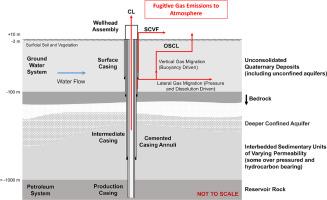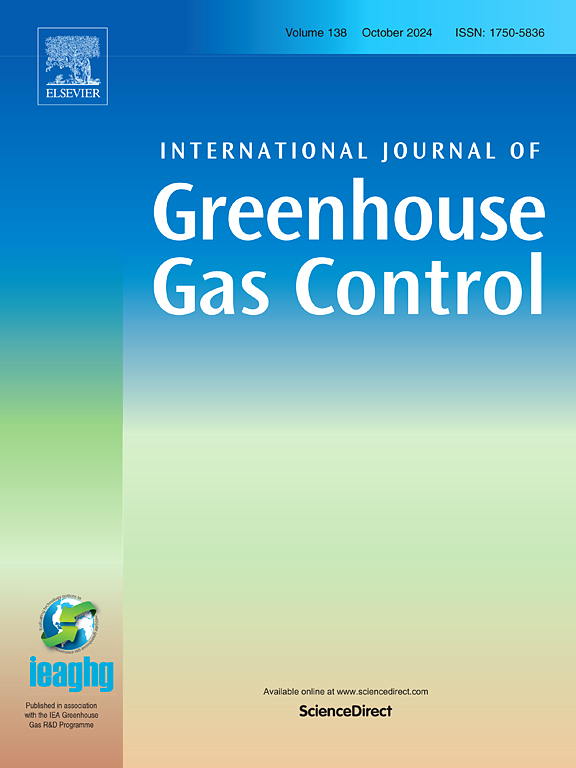Multiphase flow modelling of gas migration from a hypothetical integrity-compromised petroleum well in the peace region of North-eastern British Columbia, Canada
IF 4.6
3区 工程技术
Q2 ENERGY & FUELS
International Journal of Greenhouse Gas Control
Pub Date : 2024-09-28
DOI:10.1016/j.ijggc.2024.104261
引用次数: 0
Abstract
Well-integrity failure occurs in a small subset of petroleum wells, resulting in release of fugitive gas into intersected geologic formations. Released fugitive gas from geoenergy systems is a growing environmental concern that can contaminate groundwater aquifers and emit greenhouse gases (GHGs) to atmosphere. Currently, the roles of well-cement quality and properties of intersected geologic formations on the environmental outcomes of well-integrity failure is poorly understood. To advance understanding, we numerically modelled a hypothetical fugitive methane release from a petroleum well intersecting the Sunset Paleovalley aquifer system in Northeast British Columbia, Canada. We simulate a 10-year release and migration of fugitive gas into a two dimensional, two-phase, two-component advective flow field with the subsurface properties informed by field and laboratory data. We evaluate the effects of cement quality, gas release depth, and geologic heterogeneity on fugitive-gas containment or emission by defining and/or evaluating three key numbers: a) emission-retention ratio (ERR), b) well integrity index (WII), and c) fugitive gas mobility ratio (MR) over relevant spatiotemporal scales. We show that ERR and WII capture the bifurcated impacts of fugitive gas from petroleum wells, including groundwater contamination and atmospheric emissions. A WII close to one reduces vertical fugitive-gas migration along the well bore, fosters lateral migration into intersected geologic materials and significantly limits GHG emissions to atmosphere. MR and ERR values show fugitive-gas migration and fate are primarily controlled by the casing annulus cement quality, particularly when fugitive gas is released at shallow depths. We conclude that the quality of petroleum-well cement is among the parameters controlling the migration pathways, impacts, and fate of fugitive-gas release.

加拿大不列颠哥伦比亚省东北部和平地区一口假定完整性受损油井的天然气迁移多相流模型
油井完整性失效发生在一小部分油井中,导致逸散气体释放到相交的地质构造中。地质能源系统释放的逸散气体会污染地下含水层,并向大气排放温室气体(GHGs),是一个日益严重的环境问题。目前,人们还不太了解油井水泥质量和相交地层的性质对油井完整性失效的环境影响所起的作用。为了加深了解,我们对加拿大不列颠哥伦比亚省东北部与 Sunset Paleovalley 含水层系统相交的一口石油井的甲烷逃逸释放进行了数值模拟。我们模拟了逸散气体在二维、两相、双组分平流场中的 10 年释放和迁移过程,其地下属性参考了现场和实验室数据。我们通过定义和/或评估以下三个关键数据来评估水泥质量、气体释放深度和地质异质性对逸散气体封存或排放的影响:a)排放滞留率(ERR);b)油井完整性指数(WII);c)相关时空尺度上的逸散气体流动比率(MR)。我们的研究表明,ERR 和 WII 能够捕捉到石油油井逸散气体的分叉影响,包括地下水污染和大气排放。接近 1 的 WII 可减少沿井眼的纵向逸散气体迁移,促进横向迁移到相交的地质材料中,并显著限制向大气的温室气体排放。MR和ERR值表明,逸散气体的迁移和归宿主要受套管环空水泥质量的控制,尤其是当逸散气体在浅层释放时。我们的结论是,石油井水泥质量是控制逃逸气体释放的迁移路径、影响和归宿的参数之一。
本文章由计算机程序翻译,如有差异,请以英文原文为准。
求助全文
约1分钟内获得全文
求助全文
来源期刊
CiteScore
9.20
自引率
10.30%
发文量
199
审稿时长
4.8 months
期刊介绍:
The International Journal of Greenhouse Gas Control is a peer reviewed journal focusing on scientific and engineering developments in greenhouse gas control through capture and storage at large stationary emitters in the power sector and in other major resource, manufacturing and production industries. The Journal covers all greenhouse gas emissions within the power and industrial sectors, and comprises both technical and non-technical related literature in one volume. Original research, review and comments papers are included.

 求助内容:
求助内容: 应助结果提醒方式:
应助结果提醒方式:


